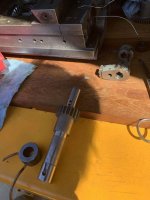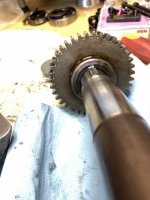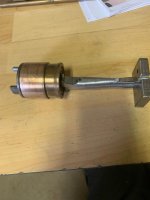Well after many weeks of cleaning and other repairs the FP1 is a goer. I would like to thank all for their assistance during this process and the availability of knowledge shared on this site, much appreciated.
As mentioned earlier my machine which had been in storage for about 10 years since purchase was found to not only have grease on the oil galleries but packed into the gearbox's also, probably to hide many past sins, which I discovered were plenty. The grese clearing process was pretty much as detailed in a number of posts, thanks Bruce for pointing me in the right direction, I drilled the gallery plugs M4 and withdrew them rather than knock through into the gallery as unsure of the height, but would have been fine. Used short M4 grub screws to fill the plug hole and reused with some Loctite 515 to seal the thread.
The felt used for the gallery restrictors I found was not the stuff I had which is known as "piano" felt which is quite dense and really did restrict passage of oil to nearly nothing, instead after having a supplier look at an original felt it is what is termed B grade felt and lets oil pass at a low rate and thanks to Bill Fisher's diagrams correct installation was easy.
The X & Z feed power drive shaft as per photo had a hard life, so put is a plug, JB weld and cross drilled another tapered hole, ended up using 3/16 pins, I think #2 throughout as that was the reamer I had with pins provided by Bob another forum member locally, they are only slightly larger than the Metric 4 ones used originally. Various bearing pullers and pushers were used, some depicted in the photos and some mods were made,the last photo is of the hand feed Z axis bevel gear, a collar was made and loctited in place to limit any further growth.
The 4th photo is the idler shaft, took some considerable effort for someone to withdraw it while the set screw was in place.
An illuminating couple of weeks, made worthwhile as the Deckel was originally a quality machine and worth the effort to bring it back to operation. There will be several posts to account for the number of photos. Thanks, Alan.
























